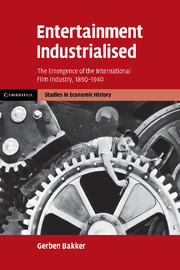Book contents
- Frontmatter
- Contents
- List of figures
- List of tables
- Acknowledgements
- Prologue
- 1 Introduction
- Part I The rise of entertainment
- Part II The rise of the international film industry
- Part III Entertainment Industrialised
- 9 International market integration: firms versus trade
- 10 Industrialising the discovery process
- 11 At the origins of increased productivity growth in services
- 12 Epilogue: after television
- Bibliography
- Index
9 - International market integration: firms versus trade
Published online by Cambridge University Press: 08 July 2009
- Frontmatter
- Contents
- List of figures
- List of tables
- Acknowledgements
- Prologue
- 1 Introduction
- Part I The rise of entertainment
- Part II The rise of the international film industry
- Part III Entertainment Industrialised
- 9 International market integration: firms versus trade
- 10 Industrialising the discovery process
- 11 At the origins of increased productivity growth in services
- 12 Epilogue: after television
- Bibliography
- Index
Summary
The last few chapters investigated how the film industry first became concentrated industrially and then geographically. A question that remains is why most of the large film companies – both the Hollywood studios and the earlier firms they replaced – strived to do their own distribution in most major film markets; in other words, why did they move their international transactions inside a multinational firm rather than doing them through the market? The current chapter addresses this question and attempts to explain how multinational enterprises became so predominant in motion pictures compared to many other industries, and to what degree the economic product characteristics of film can explain this predominance and the specific patterns of international trade that emerged.
The international integration of markets for spectator entertainment happened in three stages. In a first stage, silent film made tradeable the visual part of the performance. Sound was still provided by local inputs, such as musicians and performers who did their acts in between the short films. In a second stage, when the feature film emerged, shorts became side dishes rather than the main fare, and the second kind of performer became somewhat less common. In a third stage, talking pictures standardised, automated and made tradeable the musicians' performance and the few remaining live acts, completing the process of international market integration.
This chapter focuses on the international film trade.
- Type
- Chapter
- Information
- Entertainment IndustrialisedThe Emergence of the International Film Industry, 1890–1940, pp. 319 - 340Publisher: Cambridge University PressPrint publication year: 2008



